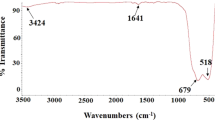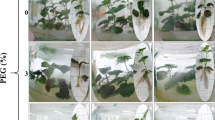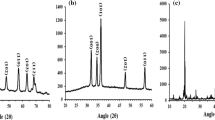Abstract
Many methodologies have been established to lessen negative impacts of salinity on plants. Of those methodologies, nanoparticles (NPs) application has achieved great importance thanks to their unique physico-chemical properties. Consequently, formerly respecting encouraging impacts of graphene oxide (GO) and proline (Pro) on different plant processes under non-stress and stress conditions, proline-functionalized graphene oxide nanoparticles “GO–Pro NPs” were synthesized and characterized. Graphite powder, as starting material, was used to synthesize GO using modified Hummers method followed by functionalization of its surface by proline in basic media. Afterward, GO–Pro NPs, GO and Pro, each at 0, 50 and 100 mg L−1 concentrations with three replications, were applied on Moldavian balm (Dracocephalum moldavica L.) plants to assay their effects under non-stress (0 mM) and salt stress (50 and 100 mM) conditions. GO–Pro NPs and Pro effectively alleviated negative effects of salinity through increasing morphological parameters, photosynthetic pigments, chlorophyll fluorescence parameters, chlorophyll index (SPAD), and membrane stability index (MSI) and decreasing hydrogen peroxide and malondialdehyde, as well. Also application of GO–Pro NPs enhanced proline, antioxidant enzymes activities, and most dominant constituents of essential oil. The highest MSI (48.87%) and proline content (15.36 µM g−1 FW) were observed in plant treated with GO–Pro NPs (50 mg L−1) under 100 mM NaCl salinity stress. The GO–Pro NPs treatment at lower dose (50 mg L−1) could be introduced as the best preservative treatment for Moldavian balm under salt stress. GO application mostly had no effect on the measured parameters announcing it as carrier for Pro to enhance its efficiency. In conclusion, GO–Pro NPs application could promote Moldavian balm performance and essential oil under salinity presenting GO–Pro NPs as new treatment against stress conditions.





Similar content being viewed by others
Data Availability
The data that support the findings of this study are available from the corresponding author upon reasonable request.
References
Abdelaziz MN, Xuan TD, Mekawy AMM, Wang H, Khanh TD (2018) Relationship of salinity tolerance to Na+ exclusion, proline accumulation, and antioxidant enzyme activity in rice seedlings. Agriculture 8:166
Ahmad P, Jaleel CA, Sharma S (2010) Antioxidant defense system, lipid peroxidation, proline-metabolizing enzymes, and biochemical activities in two Morus alba genotypes subjected to NaCl stress. Russ J Plant Physiol 57:509–517
Amini R, Ebrahimi A, Nasab ADM (2020) Moldavian balm (Dracocephalum moldavica L.) essential oil content and composition as affected by sustainable weed management treatments. Ind Crops Prod 150:112416
Aprotosoaie AC, Mihai CT, Vochita G, Rotinberg P, Trifan A, Luca SV, Miron A (2016) Antigenotoxic and antioxidant activities of a polyphenolic extract from European Dracocephalum moldavica L. Ind Crops Prod 79:248–257
Carović-Stanko K, Petek M, Martina G, Pintar J, Bedeković D, Ćustić MH, Šatović Z (2016) Medicinal plants of the family Lamiaceaeas functional foods–a review. Czech J Food Sci 34:377
Chen S, Wei Y, Zou L, Lu H, Xu Y, Hua J, Sun H, Peng X, Liu B (2017) Preparation and characterization of multi-walled carbon nanotubes decorated with silver nanoparticles through ultraviolet irradiation reduction. App Organometal Chem 31:e3666
Chen J, Li H, Zhang L, Du C, Fang T, Hu J (2020) Direct reduction of graphene oxide/nanofibrillated cellulose composite film and its electrical conductivity research. Sci Rep 10:1–10
Cornelissen JHC, Lavorel S, Garnier E, Díaz S, Buchmann N, Gurvich DE, Poorter H (2003) A handbook of protocols for standardized and easy measurement of plant functional traits worldwide. Aust J Bot 51(4):335–380
Ebadollahi R, Jafarirad S, Kosari-Nasab M, Mahjouri S (2019) Effect of explant source, perlite nanoparticles and TiO2/perlite nanocomposites on phytochemical composition of metabolites in callus cultures of Hypericum perforatum. Sci Rep 9:1–15
Eftekhari-Sis B, Rezazadeh Z, Akbari A, Amini M (2018) 8-hydroxyquinoline functionalized graphene oxide: an efficient fluorescent nanosensor for Zn 2+ in aqueous media. J Fluorescence 28(5):1173–1180
El-Din KMG, Abd El-Wahed MSA (2005) Effect of some amino acids on growth and essential oil content of chamomile plant. Int J Agric Biol 7:376–380
Feng P, Geng B, Cheng Z, Liao X, Pan D, Huang J (2019) Graphene quantum dots-induced physiological and biochemical responses in mung bean and tomato seedlings. Braz J Bot 421:29–41
Ganjavi AS, Oraei M, Gohari G, Akbari A, Faramarzi A (2021) Glycine betaine functionalized graphene oxide as a new engineering nanoparticle lessens salt stress impacts in sweet basil (Ocimum basilicum L.). Plant Physiol Biochem 162:14–26
Ghaffari H, Tadayon MR, Nadeem M, Cheema M, Razmjoo J (2019) Proline-mediated changes in antioxidant enzymatic activities and the physiology of sugar beet under drought stress. Acta Physiol Plant 4:23
Gohari G, Mohammadi A, Akbari A, Panahirad S, Dadpour MR, Fotopoulos V, Kimura S (2020a) Titanium dioxide nanoparticles (TiO2 NPs) promote growth and ameliorate salinity stress effects on essential oil profile and biochemical attributes of Dracocephalum moldavica. Sci Rep 10:1–14
Gohari G, Safai F, Panahirad S, Akbari A, Rasouli F, Dadpour MR, Fotopoulos V (2020b) Modified multiwall carbon nanotubes display either phytotoxic or growth promoting and stress protecting activity in Ocimum basilicum L. in a concentration-dependent manner. Chemosphere 249:126171
Hayat S, Hayat Q, Alyemeni MN, Wani AS, Pichtel J, Ahmad A (2012) Role of proline under changing environments: a review. Plant Signal Behav 7:1456–1466
Hemmati S, Mehrazin L, Pirhayati M, Veisi H (2019) Immobilization of palladium nanoparticles on Metformin-functionalized graphene oxide as a heterogeneous and recyclable nanocatalyst for Suzuki coupling reactions and reduction of 4-nitrophenol. Polyhedron 158:414–422
Hmidi D, Abdelly C, Ashraf M, Messedi D (2018) Effect of salinity on osmotic adjustment, proline accumulation and possible role of ornithine-δ-aminotransferase in proline biosynthesis in Cakile maritima. Physiol Mol Biol Plants 24:1017–1033
Hoque MA, Banu MNA, Okuma E, Amako K, Nakamura Y, Shimoishi Y, Murata Y (2007) Exogenous proline and glycinebetaine increase NaCl-induced ascorbate–glutathione cycle enzyme activities, and proline improves salt tolerance more than glycinebetaine in tobacco Bright Yellow-2 suspension-cultured cells. J Plant Physiol 164:1457–1468
Huang Y, Bie Z, Liu Z, Zhen A, Wang W (2009) Protective role of proline against salt stress is partially related to the improvement of water status and peroxidase enzyme activity in cucumber. Soil Sci Plant Nut 55:698–704
Hummers WS Jr, Offeman RE (1958) Preparation of graphitic oxide. J Am Chem Soc 80:1339–1339
Hussain AI, Anwar F, Sherazi STH, Przybylski R (2008) Chemical composition, antioxidant and antimicrobial activities of basil (Ocimum basilicum) essential oils depends on seasonal variations. Food Chem 108:986–995
Ioannou A, Gohari G, Papaphilippou P, Panahirad S, Akbari A, Dadpour MR, Krasia-Christoforou T, Fotopoulos V (2020) Advanced nanomaterials in agriculture under a changing climate: the way to The future? Environ Exp Bot 2:104048
Kamran M, Parveen A, Ahmar S, Malik Z, Hussain S, Chattha MS, Saleem MH, Adil M, Heidari P, Chen JT (2020) An overview of hazardous impacts of soil salinity in crops, tolerance mechanisms, and amelioration through selenium supplementation. Int J Mol Sci 21:148
Kaya C, Tuna AL, Ashraf M, Altunlu H (2007) Improved salt tolerance of melon (Cucumis melo L.) by the addition of proline and potassium nitrate. Environ Exp Bot 60:397–403
Khalid KA, da Silva JAT (2010) Yield, essential oil and pigment content of Calendula officinalis L. flower heads cultivated under salt stress conditions. Sci Hortic 126:297–305
Khan MN, Mobin M, Abbas ZK, AlMutairi KA, Siddiqui ZH (2017) Role of nanomaterials in plants under challenging environments. Plant Physiol Biochem 110:194–209
Khanna-Chopra R, Semwal VK, Lakra N, Pareek A (2019) Proline—a key regulator conferring plant tolerance to salinity and drought. Plant tolerance to environmental stress. CRC Press, Boca Raton, pp 59–80
Kim GB, Nam YW (2013) A novel Δ1-pyrroline-5-carboxylate synthetase gene of Medicago truncatula plays a predominant role in stress-induced proline accumulation during symbiotic nitrogen fixation. J Plant Physiol 170:291–302
Kubala S, Wojtyl Ł, Quinet M, Lechowska K, Lutts S, Garnczarska M (2015) Enhanced expression of the proline synthesis gene P5CSA in relation to seed osmopriming improvement of Brassica napus germination under salinity stress. J Plant Physiol 183:1–12
Lichtenthaler HK (1987) Chlorophylls and carotenoids: pigments of photosynthetic biomembranes. Method Enzym 148:350–382
Ling Q, Huang W, Jarvis P (2011) Use of a SPAD-502 meter to measure leaf chlorophyll concentration in Arabidopsis thaliana. Photosynth Res 107:209–214
Marín Velázquez JA, Andreu Puyal P, Carrasco A, Arbeloa Matute A (2009) Determination of proline concentration, an abiotic stress marker, in root exudates of excised root cultures of fruit tree rootstocks under salt stress. Revue Des Régions Arides 24:722–727
Mozafari AA, Ghaderi N (2018) Grape response to salinity stress and role of iron nanoparticle and potassium silicate to mitigate salt induced damage under in vitro conditions. Physiol Mol Biol Plants 24:25–35
Nemati Lafmejani Z, Jafari AA, Moradi P, Ladan Moghadam A (2018) Impact of foliar application of iron-chelate and Iron nano Particles on some morpho-physiological traits and essential oil composition of peppermint (Mentha piperita L.). J Essent Oils Bear Plants 21:1374–2138
Ozden M, Demirel U, Kahraman A (2009) Effects of proline on antioxidant system in leaves of grapevine (Vitis vinifera L.) exposed to oxidative stress by H2O2. Sci Hortic 119:163–168
Perveen SHAGUFTA, Nazir M (2018) Proline treatment induces salt stress tolerance in maize (Zea Mays L. CV. Safaid Afgoi). Pak J Bot 50:1265–1271
Rady MM, Taha RS, Mahdi AH (2016) Proline enhances growth, productivity and anatomy of two varieties of Lupinus termis L. grown under salt stress. S Afr J Bot 102:221–227
Reddy PS, Jogeswar G, Rasineni GK, Maheswari M, Reddy AR, Varshney RK, Kishor PK (2015) Proline over-accumulation alleviates salt stress and protects photosynthetic and antioxidant enzyme activities in transgenic sorghum [Sorghum bicolor (L.) Moench]. Plant Physiol Biochem 94:104–113. https://doi.org/10.1016/j.plaphy.2015.05.014
Ren W, Chang H, Teng Y (2016) Sulfonated graphene-induced hormesis is mediated through oxidative stress in the roots of maize seedlings. Sci Total Environ 572:926–934
Rico CM, Peralta-Videa JR, Gardea-Torresdey JL (2015) Chemistry, biochemistry of nanoparticles, and their role in antioxidant defense system in plants. In: Nanotechnology and Plant Sciences. Springer, New York, pp 1–17
Safikhan S, Chaichi MR, Khoshbakht K, Amini A, Motesharezadeh B (2018) Application of nanomaterial graphene oxide on biochemical traits of milk thistle (Silybum marianum L.) under salinity stress. Aust J Crop Sci 12:931
Sairam RK, Shukla DS, Saxena DC (1997) Stress induced injury and antioxidant enzymes in relation to drought tolerance in wheat genotypes. Biol Plant 40:357–364
Sharma S, Uttam R, Sarika Bharti A, Uttam KN (2019) Interaction of zinc oxide and copper oxide nanoparticles with chlorophyll: a fluorescence quenching study. Anal Lett 52:1539–1557
Sinha S, Saxena R, Singh S (2005) Chromium induced lipid peroxidation in the plants of Pistia stratiotes L.: role of antioxidants and antioxidant enzymes. Chemosphere 58:595–604
Stewart RR, Bewley JD (1980) Lipid peroxidation associated with accelerated aging of soybean axes. Plant Physiol 65:245–248
Teh CY, Shaharuddin NA, Ho CL, Mahmood M (2016) Exogenous proline significantly affects the plant growth and nitrogen assimilation enzymes activities in rice (Oryza sativa) under salt stress. Acta Physiol Plant 38:151
Wang Q, Zhao S, Zhao Y, Rui Q, Wang D (2014) Toxicity and translocation of graphene oxide in Arabidopsis plants under stress conditions. RSC Adv 4:60891–60901
Wani SH, Kumar V, Khare T, Guddimalli R, Parveda M, Solymosi K, Suprasanna P, Kishor PK (2020) Engineering salinity tolerance in plants: progress and prospects. Planta 251:1–29
Yu W, Sisi L, Haiyan Y, Jie L (2020) Progress in the functional modification of graphene/graphene oxide: a review. RSC Adv 10(26):15328–15345
Zali AG, Ehsanzadeh P (2018) Exogenous proline improves osmoregulation, physiological functions, essential oil, and seed yield of fennel. Ind Crops Prod 111:133–140
Zali AG, Ehsanzadeh P, Szumny A, Matkowski A (2018) Genotype-specific response of Foeniculum vulgare grain yield and essential oil composition to proline treatment under different irrigation conditions. Ind Crops Prod 124:177–185
Zhang M, Gao B, Chen J, Li Y (2015) Effects of graphene on seed germination and seedling growth. J Nanoparticle Res 17:78
Zheng JL, Zhao LY, Wu CW, Shen B, Zhu AY (2015) Exogenous proline reduces NaCl-induced damage by mediating ionic and osmotic adjustment and enhancing antioxidant defense in Eurya emarginata. Acta Physiol Plant 37:181
Zouari M, Ahmed CB, Zorrig W, Elloumi N, Rabhi M, Delmail D, Ben Rouina B, Labrousse P, Abdallah FB (2016) Exogenous proline mediates alleviation of cadmium stress by promoting photosynthetic activity, water status and antioxidative enzymes activities of young date palm (Phoenix dactylifera L.). Ecotoxic Environ Safe 128:100–108
Acknowledgements
These results were obtained from Ph.D. thesis of Seyyed Fazel Fatehi. We expressed the appreciation to Miyaneh Branch, Islamic Azad University, Miyaneh, Iran and central laboratory of University of Maragheh, Iran for providing the experimental site and laboratory facilities.
Funding
This research did not receive any specific Grant from funding agencies in the public, commercial, or not-for-profit sectors.
Author information
Authors and Affiliations
Contributions
GG, MA, and AA designed the experimental setup. SFF and AF performed greenhouse experiments, biochemical, and essential oil studies. AA synthesized nanomaterial. GG, MA, and AA analyzed data and results, while GG and AA wrote the manuscript. GG and MA were supervisors.
Corresponding author
Ethics declarations
Conflict of interest
The authors declare that they have no known competing financial interests or personal relationships that could have appeared to influence the work reported in this paper.
Additional information
Handling Editor: Durgesh Kumar Tripathi.
Publisher's Note
Springer Nature remains neutral with regard to jurisdictional claims in published maps and institutional affiliations.
Supplementary Information
Below is the link to the electronic supplementary material.
Rights and permissions
About this article
Cite this article
Fatehi, S.F., Oraei, M., Gohari, G. et al. Proline-Functionalized Graphene Oxide Nanoparticles (GO–Pro NPs) Mitigate Salt-Induced Adverse Effects on Morpho-Physiological Traits and Essential Oils Constituents in Moldavian Balm (Dracocephalum moldavica L.). J Plant Growth Regul 41, 2818–2832 (2022). https://doi.org/10.1007/s00344-021-10477-1
Accepted:
Published:
Issue Date:
DOI: https://doi.org/10.1007/s00344-021-10477-1




